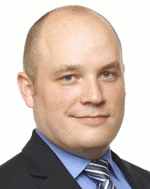 |
|
Biography
Josef Weinbub holds a bacherlor's degree in electrical engineering, a master's degree in microelectronics, and a doctoral degree in technical sciences from the Technische Universität Wien. He was a visiting researcher at the EPCC, University of Edinburgh and at the Device Modelling Group, University of Glasgow, Scotland, UK as well as at Silvaco Inc, Santa Clara, CA, USA. He leads the Christian Doppler Laboratory for High Performance TCAD and investigates cutting-edge research problems in the area of micro- and nanoelectronics, focusing on high performance computational approaches.
Lense-Governed Wigner Signed Particle Quantum Dynamics for Entangletronics
Electron state control refers to the ability to use specially shaped potentials (acting as lenses) to focus, guide, reshape or split an electron state into components. In particular, the electron state can be decomposed by the lense into distinct density peaks, which may be guided to propagate in the desired directions. Of particular importance are scenarios where the evolution process retains initial coherence, which is then destroyed by decoherence processes like scattering with lattice vibrations, i.e. phonons. The electron dynamics, being a complicated interplay between such processes, can be conveniently analyzed in phase space using Wigner theory.
Quantum coherence is the underlying concept of quantum information disciplines and emerging disciplines in quantum engineering, such as entangletronics. The theory follows the idea of the corresponding quantum theory of entanglement. Moreover, it has been demonstrated that the two concepts are quantitatively equivalent.
The resulting criteria for coherence in phase space, in conjunction with a Wigner signed particle method, are applied to analyze a splitting mechanism by the electron-lense dynamics. Fig. 1 shows the electron splitting experiment, where an initial Wigner pure state (corresponding to a minimum uncertainty wave packet) moves along the y-direction towards the lense. In particular, the difference of the coherent and phonon-modified densities is shown. The regions where the latter dominates (the difference is negative) are marked in blue. This example illustrates well the transition from quantum to classical behavior. After 150 fs, the spread of the phonon-aware density is restricted in comparison with the quantum counterpart, clearly demonstrating scattering-induced localization.
It is shown that the Wigner formalism offers a legitimate formulation of the recently developed theory of coherence. The signed particle model of Wigner evolution, used for analysis of electrostatic lense-controlled electron dynamics, provides an intuitive physical picture of the processes that maintain coherence. In particular, coherence is associated with the existence of nondiagonal Wigner basis states. In this picture, scattering works against the quantum action of the potential, pushing the evolution towards the classical behavior associated with incoherent states.

Fig. 1: Difference between the coherent densities and those affected by phonons after 75 fs evolution. Phonon scattering mechanisms for silicon are considered. The white shape shows the electrostatic lense.

Fig. 2: 150 fs evolution of the difference between the coherent densities and those affected by phonons. The latter resembles the point-like structure of spreading by scattering-induced diffusion of an initial distribution of classical particles.



